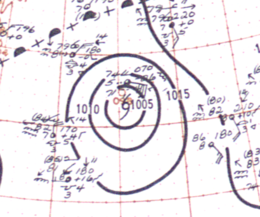1948 Bermuda–Newfoundland hurricane
| Category 4 major hurricane (SSHWS/NWS) | |

Surface weather analysis of the hurricane on September 13
|
|
| Formed | September 4, 1948 |
|---|---|
| Dissipated |
September 16, 1948 (Extratropical after September 15) |
| Highest winds |
1-minute sustained: 135 mph (215 km/h) |
| Lowest pressure | ≥ 958 mbar (hPa); 28.29 inHg |
| Fatalities | 8 total |
| Damage | $400,000 (1948 USD) |
| Areas affected | Bermuda, Newfoundland |
| Part of the 1948 Atlantic hurricane season | |
The 1948 Bermuda hurricane (Air Weather Service designation: Dog) was an intense and long-lived Cape Verde-type tropical cyclone that wrought significant damage to Bermuda and areas of Newfoundland in September 1948. The storm was the eighth named storm and third hurricane of the annual hurricane season. Originating as a tropical wave off the coast of Africa on September 4, the cyclone tracked a general westward path for much of its initial stages as it gradually intensified, reaching tropical storm intensity shortly after development and then hurricane intensity a day later. After reaching a longitude roughly equal to that of the Lesser Antilles, the hurricane began to curve northward on a parabolic track, bringing it near Bermuda at peak intensity as a Category 4 hurricane on September 13. Afterwards, the hurricane began to accelerate northeastwards and weaken. The waning tropical cyclone grazed Cape Race before transitioning into an extratropical cyclone on September 15; these remnants persisted for an additional day.
Despite never making landfall, the tropical cyclone disrupted numerous shipping lanes and inflicted damage on Bermuda and Newfoundland. In the former, the hurricane brought winds in excess of 100 mph (160 km/h), downing power lines and felled trees. Property damage also resulted from the strong winds. Overall damage on the island totaled $400,000. After passing west of Bermuda, the tropical cyclone tracked across numerous shipping lanes. Two ships, the Leicester and Gaspar, encountered the hurricane and became stricken in open waters. Though most people were rescued from both ships, six people perished on the former while one died on the latter. Beginning on September 15, the hurricane tracked east of Newfoundland, producing heavy rainfall on land. The precipitation flooded roads and caused streams to overflow, inundating additional areas. On the island, two people were killed. Overall, the hurricane caused eight fatalities.
...
Wikipedia
